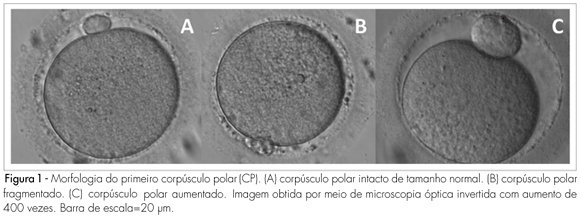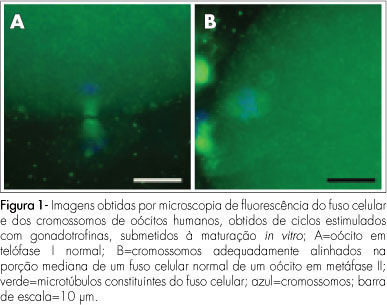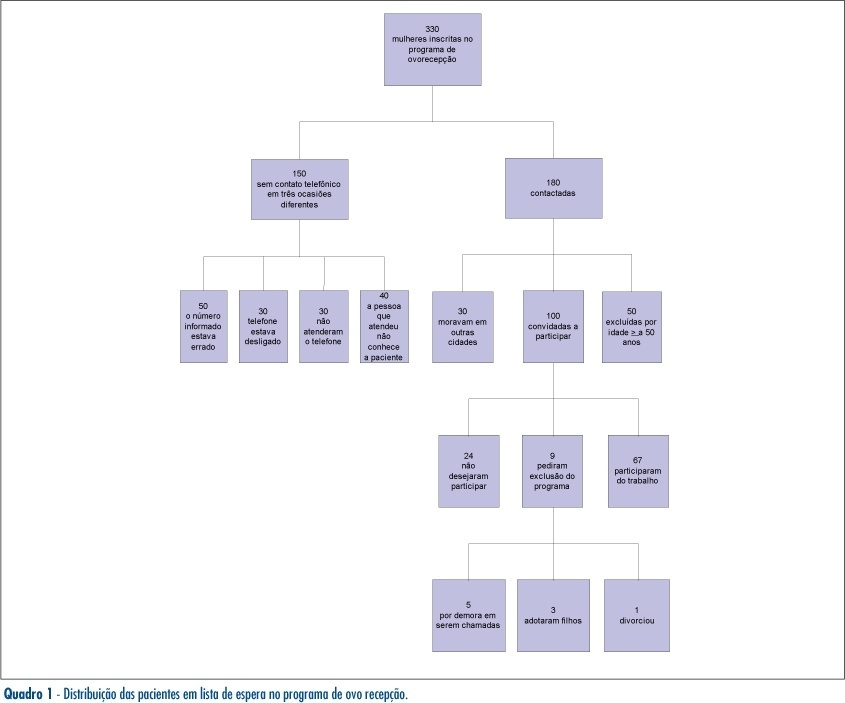Summary
Revista Brasileira de Ginecologia e Obstetrícia. 2009;31(5):230-234
DOI 10.1590/S0100-72032009000500005
PURPOSE: to evaluate the patient's age as an outcome predictor in an in vitro fertilization (IVF) program. METHODS: transversal study, which has included 302 women with ages varying from 24 to 46 years old, submitted to IVF, from May 2005 to July 2007. The patients were divided in three groups, according to their age: G<35 (n=161), G 36-39 (n=89) e G>40 (n=52). The number of collected oocytes, the fertilization rates, the number of transferred embryos, the embryonary quality and the pregnancy rate were evaluated. Statistical analysis was realized through Kruskal-Wallis variance analysis and χ2 test. RESULTS: in the G<35 group, an average of 8.8 oocytes by patient was obtained; in the G 36-49 group, 7.4; and in the G>40 group, 1.6. The number of oocytes obtained in G>40 group was significantly lower than in the other two groups (p<0.001).The fertilization rate was similar in the three groups, 61.4, 65.8 e 64.6% (p=0.2288), respectively. The percentage of good quality embryos was not statistically different among the three groups either, with rates of 57.4, 63.2 and 56.0% (p=0.2254), respectively. The average number of transferred embryos in each group was 3.1 (G<35), 2.8 (G 36-39) and 1.5 (G>40), respectively, with statistically significant decrease in the G>40 group (p<0.001). Concerning pregnancy rates, the G>40 group has presented a rate of 9.6%, a result which is significantly lower (p=0.0330) than the one presented by the G<35 and G 36-39 groups (26.1 e 27.0%, respectively), with no significant difference between themselves. CONCLUSIONS: though the embryonary quality is not different among women from different age groups, the number of collected oocytes, the number of transferred embryos and the pregnancy rate indicate that the women's age is an important predictive factor of success for the techniques of assisted reproduction and should be taken into consideration when this kind of treatment is proposed to women over 40.
Summary
Revista Brasileira de Ginecologia e Obstetrícia. 2009;31(3):138-141
DOI 10.1590/S0100-72032009000300006
PURPOSE: to report three cases of spontaneous gestation in women with polycystic ovarian syndrome (PCOS), that occurred in the months subsequent to transvaginal oocyte retrieval for in vitro maturation (IVM). METHODS: three infertile patients with PCOS, submitted to oocytes' IVM without previous ovarian stimulation, were included in the study. During the procedure of oocytes' collection, each ovary was drilled from four to eight times. RESULTS: none of the patients got pregnant with the IVM technique. Evaluating the cases' follow-up, in seven months after the procedure, the three patients got pregnant without the help of techniques of assisted reproduction, which resulted in three births. CONCLUSIONS: the multiple drillings in the ovary of these patients with PCOS, during the process to collect oocytes, may have contributed to their pregnancy in the months following the procedure.
Summary
Revista Brasileira de Ginecologia e Obstetrícia. 2008;30(7):360-365
DOI 10.1590/S0100-72032008000700007
PURPOSE: to determine the relationship between the morphology of the first spindle pole of human oocytes and rates of fertilization, fragmentation and embryo quality in procedures of Intracytoplasmic Sperm Injection (ICSI). METHODS: retrospective study of 582 consecutive ICSI cycles, from July 2003 to July 2005. The morphology of the first spindle pole (SP) was assessed through the analysis of 3,177 oocytes in metaphase II, immediately before the ICSI procedure, always by the same observer. SP has been classified in the following categories: normal size intact, fragmented or augmented SP. Fertilization rate and fragmentation, and the number and rate of good quality embryos in each one of the three groups studied have been evaluated, 48 hours after ICSI (D2). Embryos with four cells, without fragmentation and with symmetric blastomeres in D2 were considered as of good quality. RESULTS: rates of fertilization, fragmentation and of good quality embryo formation, resulting from oocyte insemination, with augmented SP (20.7, 16.7 and 5% respectively) were significantly lower than the ones from intact and normal size SP (70.8, 62.5 and 19%, respectively) or from fragmented SP oocytes (69.7, 60.5 and 17.1%, respectively). CONCLUSIONS: it has been observed that the presence of augmented first spindle pole is related to worse rates of fertilization, fragmentation and bad quality embryo formation. Nevertheless, fragmentation in the first spindle pole of the oocyte does not seem to affect ICSI results.

Summary
Revista Brasileira de Ginecologia e Obstetrícia. 2008;30(9):466-469
DOI 10.1590/S0100-72032008000900007
Heterotopic gestation, characterized by the presence of combined topic and ectopic gestation, until recently was considered to be a rare event occurring in 1:30,000 pregnancies. With the appearance of assisted reproduction techniques, this incidence increased to 1:100-500 gestations. Early diagnosis is difficult and frequently is made when the uterine tube has already ruptured. It's presented a case of heterotopic pregnancy diagnosed by means of a clinical presentation of hemorrhagic acute abdomen, with good progression of the topic gestation that resulted in birth. It's pointed out the importance of considering this pathology in the evaluation of women submitted to in vitro fertilization, with the objective of early treatment.
Summary
Revista Brasileira de Ginecologia e Obstetrícia. 2008;30(8):413-419
DOI 10.1590/S0100-72032008000800007
PURPOSE: to evaluate the meiotic spindle and the chromosome distribution of in vitro mature oocytes from stimulated cycles of infertile women with endometriosis, and with male and/or tubal infertility factors (Control Group), comparing the rates of in vitro maturation (IVM) between the two groups evaluated. METHODS: fourteen patients with endometriosis and eight with male and/or tubal infertility factors, submitted to ovarian stimulation for intracytoplasmatic sperm injection have been prospectively and consecutively selected, and formed a Study and Control Group, respectively. Immature oocytes (46 and 22, respectively, from the Endometriosis and Control Groups) were submitted to IVM. Oocytes presenting extrusion of the first polar corpuscle were fixed and stained for microtubules and chromatin evaluation through immunofluorescence technique. Statistical analysis has been done by the Fisher's exact test, with statistical significance at p<0.05. RESULTS: there was no significant difference in the IVM rates between the two groups evaluated (45.6 and 54.5% for the Endometriosis and Control Groups, respectively). The chromosome and meiotic spindle organization was observed in 18 and 11 oocytes from the Endometriosis and Control Groups, respectively. In the Endometriosis Group, eight oocytes (44.4%) presented themselves as normal metaphase II (MII), three (16.7%) as abnormal MII, five (27.8%) were in telophase stage I and two (11.1%) underwent parthenogenetic activation. In the Control Group, five oocytes (45.4%) presented themselves as normal MII, three (27.3%) as abnormal MII, one (9.1%) was in telophase stage I and two (18.2%) underwent parthenogenetic activation. There was no significant difference in meiotic anomaly rate between the oocytes in MII from both groups. CONCLUSIONS: the present study data did not show significant differences in the IVM or in the meiotic anomalies rate between the IVM oocytes from stimulated cycles of patients with endometriosis, as compared with controls. Nevertheless, they have suggested a delay in the outcome of oocyte meiosis I from patients with endometriosis, shown by the higher proportion of oocytes in telophase I observed in this group.

Summary
Revista Brasileira de Ginecologia e Obstetrícia. 2007;29(9):459-464
DOI 10.1590/S0100-72032007000900004
PURPOSE: describe epidemiologic profile of patients enrolled in the oocyte reception program at Hospital Regional da Asa Sul (HRAS) in Brasília, Distrito Federal, Brazil, and its main indications. METHODS: prospective descriptive study, in which 330 patients enrolled in the waiting list program were studied. Sixty-seven women, irrespective of their infertility factor and that had not been contemplated by the treatment were included. Thirty women who lived in other cities, 50 patients over 50 years old, 24 patients that didn't want to take part in the study, nine patients that asked to be left out of the program and 150 women that couldn't be found by phone calls were excluded. The 67 patients included were interviewed in order to answer a questionnaire. Their medical handbook was recovered to confirm that the investigation required to establish the cause of infertility had been done. The data was registered and analyzed by SPSS version 12.0 software. RESULTS: the patients' epidemiologic profile is age range 40 to 49 years old (82%), non-white skinned (77,6%), catholic (71,6%), married (59,7%), in high school (76,1%), secondary infertility (53,6%) from which due to tubal sterilization (40,3%) and those ones who started trying to conceive before 35 years old (91%). The main indication to enroll in this oocyte reception program was age and low ovarian reserve. CONCLUSION: the results demonstrated the indiscriminate tubal sterilization. The oocyte reception program benefits women with reserved reproductive prognostic.

Summary
Revista Brasileira de Ginecologia e Obstetrícia. 2007;29(7):340-345
DOI 10.1590/S0100-72032007000700003
PURPOSE: to evaluate the efficacy of in vitro fertilization (IVF) with intracytoplasmic sperm injection (ICSI) in natural cycle (NC). METHODS: retrospective clinical trial that evaluated 70 treatment cycles in 60 couples that were submitted to IVF treatment with ICSI in NC performed in private clinic from 1999 until 2003. It was performed daily ultrasound monitorization or on alternate days, and urinary LH dosage when the follicle reached 16 mm of diameter. It was scheduled egg retrieval when the follicle reached 18 mm of diameter and 36 hours after hCG administration when the LH test was negative. Embryo transfer was performed 48 to 52 hours after ICSI. RESULTS: 70 ICSI cycles in 60 patients were performed and the indications of treatment included: male factor (47.1%), tubal factor (37.1%), associated factors (8.7%), unknown infertility (7.1%). Out of 70 cycles, 18 cycles were cancelled (25.7% of cancellation rate). Out of 52 patients that were submitted to ovarian punction to oocyte retrieval we found mature oocytes in 77% of the cases (40 cycles), in four cases we collected immature oocytes and in eight cases we could not found it. We had 70% of fertilization rate and only one fertilized oocyte did not achieve the cleavage stage. So, the transfers rate per punction and per mature oocyte was 52% and 67.5%, respectively. We had 11.4% of pregnancy rate per cycle, 15.4% per punction and 29.6% per embryo transfer. CONCLUSIONS: FIV/ICSI in NC seem to be a satisfactory option of treatment, with low costs and complications (multiple gestation and Ovarian Hyperstimulation Syndrome), mainly in poor responder patients and in poor populations.
Summary
Revista Brasileira de Ginecologia e Obstetrícia. 2007;29(4):205-210
DOI 10.1590/S0100-72032007000400007
PURPOSE: to evaluate the experience of an assisted reproduction center that uses depot administration of half-dose of GnRH agonist for pituitary suppression in assisted reproductive cycles. METHODS: prospective study that evaluated in vitro fertilization or intracytoplasmatic sperm injection (IVF/ICSI) cycles utilizing half-dose of leuprolide acetate between August 2005 and March 2006. Recombinant FSH was administered for controlled ovarian induction based on the protocol. hCG was administered when at least one follicle reached 19 mm in diameter. IVF or ICSI was performed according to infertility factor. Up to four embryos were transferred on the second or third day after oocyte retrieval. Progesterone supplementation was initiated on the same day of oocyte retrieval, and after 14 days beta-hCG was measured. The following parameters were evaluated: number of aspirated cycles, cancelled cycles, transferred cycles, total dose of FSH employed, number of mature oocytes retrieved, fertilization rate, number of transferred embryos, embryo implantation rate, and pregnancy rate. RESULTS: A hundred and nine IVF/ICSI cycles were initiated. The mean age of the patients was 34.9 years. We observed 1.8% of cancellation rate. The mean total dose of gonadotrophins employed was 1,905 IU per cycle. We obtained 86.5% of mature oocytes and the fertilization rate was 76.3%. The mean number of embryos transferred was 2.7. Pregnancy rates per aspiration and per transfer were 25.2 and 25.7%, respectively. Of those who reached pregnancy, 26.3% were twins and 5.3% were triplets. CONCLUSIONS: the half-dose of GnRH depot employed for pituitary suppression was a useful alternative for ovarian stimulation in IVF cycles because it is comfortable and practical for the patient, besides its low cost.